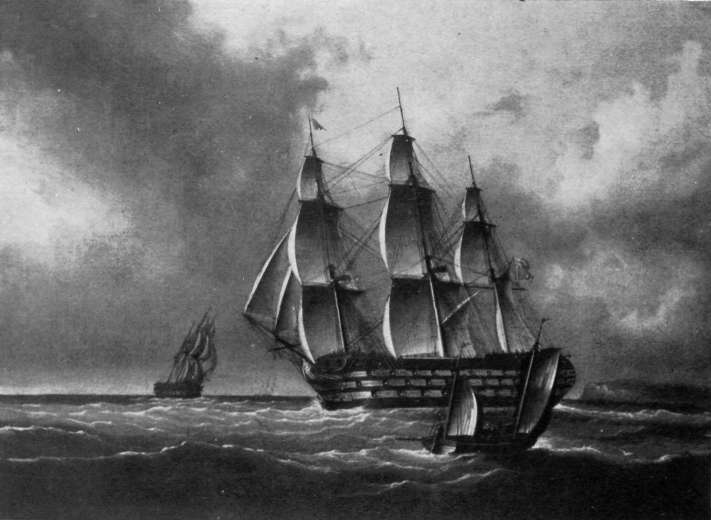The Ships-of-the-Line
Rear-Admiral Chads was known for his gunnery skills. I would give him the Gunner Admiral Archetype, as during the Baltic campaign, admiral Sir Charles Napier claimed that Chads ‘knew more about gunnery than any man in the service'.
How about rules?
| Cost | Sailing | Discipline | Boarding | Gunnery | Hull | |
|---|---|---|---|---|---|---|
| Flagship | 56 | 4 | 8 | 7 | 8 | 7 |
| Regular | 52 | 4 | 6 | 7 | 8 | 7 |
The game gives the amount of guns to a 3rd rate ship as 64-84 and for 4th rate ships 44-54. This is depicted as Gunnery 8 for 3rd rate ships and 6 for 4th rate ships. The logical new value after the reduction of guns in the Blenheim class would thus be 7.
After reduction of the hull to a single deck and knowing that the 4rd rate ships tended to be two-deckers, the amount of Hull should be reduced. A British 4th rate ship has a Hull value of 5 and a 5th rate Frigate has a hull value of 3. Still, given that these were originally bigger ships than 4th rates, I'd not reduce the Hull value to less than 5, so let's have that.
Now... the conversion to steam power should provide some advantages as well! The engine provides nearly 9 knots of speed and a fully rigged 1st rate ship-of-the-line such as HMS Victory can move at 11 knots. The rigging was made lighter, so a maximum speed of 9 knots would probably still apply. I would probably keep the Sailing value at 4, but reduce the cost of Tacking to 1 sailing point and enable them to make tight turns even when Running. I would also give the steamships +1 to the sailing roll when Close-Hauled or in Irons. They should not be faster than sailships when Reaching or Running, but should have distinct advantage to sailships when the wind conditions are not optional. Also, removing Anchor-tokens should be a breeze.
| Cost | Sailing | Discipline | Boarding | Gunnery | Hull | |
|---|---|---|---|---|---|---|
| Flagship | ? | 4 | 8 | 7 | 7 | 5 |
| Regular | ? | 4 | 6 | 7 | 7 | 5 |
I've left the costs as a question mark, since I really have no idea on how to balance these yet... but perhaps the regular point costs would be used when calculating morale. I need to test these modifications first before I can make decisions on the matter.
The Frigates
The French
Asmodée
20 guns, French Gomer-class paddle frigate, launched 20 October 1841 at RochefortPhlegeton
Darien
14 guns, converted French paddle packet (begun as Transatlantic Packetboat No.1), 14, launched 6 October 1842 at Cherbourg. Probably resembled Gomer class steam frigates more or less, so I can use the same model as for Asmodée.Rules for the French Frigates
| Cost | Sailing | Discipline | Boarding | Gunnery | Hull | |
|---|---|---|---|---|---|---|
| 5th rate (frigate) | 31 | 7 | 4 | 3 | 2 | 3 |
| 6th rate (corvette) | 16 | 8 | 3 | 2 | 1 | 1 |
If I've understood correctly, both Asmodée and Phlegeton had 20 guns whilst Darien had 14 guns. This would be adjusted to Gunnery 1 for both classes. A "quick fix" would be thus.
| Cost | Sailing | Discipline | Boarding | Gunnery | Hull | |
|---|---|---|---|---|---|---|
| French paddle frigate | ? | 7 | 4 | 3 | 1 | 3 |
| French screw corvette | ? | 8 | 3 | 2 | 1 | 1 |
The British
H.M.S. Arrogant
16-gun steam powered paddle frigate of the Royal Navy built at Pembroke Dockyard and launched on 30 April 1851.
Rules for the British Frigates
Here are the stats for napoleonic British frigates, gun stats as previously:| Cost | Sailing | Discipline | Boarding | Gunnery | Hull | |
|---|---|---|---|---|---|---|
| 5th rate frigate | 26 | 6 | 5 | 3 | 4 | 3 |
| 6th rate frigate | 14 | 7 | 4 | 2 | 2 | 1 |
| Cost | Sailing | Discipline | Boarding | Gunnery | Hull | |
|---|---|---|---|---|---|---|
| Arrogant and Amphion | ? | 6 | 5 | 3 | 4 | 3 |
| Valorous | ? | 7 | 4 | 2 | 1 | 1 |
Steamship: May make tight turns even when Running. Tacking costs only 1 Sailing Point. +1 to roll when Close-Hauled or in Irons. Succeeds automatically on Discipline rolls to remove Anchor tokens.
Sloops
H.M.S Driver
Sloop rules
| Cost | Sailing | Discipline | Boarding | Gunnery | Hull | |
|---|---|---|---|---|---|---|
| 3 x wooden paddle sloops | ? | 7 | 4 | 2 | 1 | 1 |







.jpg)


_sinking_off_Gibraltar.jpg)















 Still, the game plays very fast and if you want to play a quick game with friends who also have a busy schedulr, TPL certainly fills that niche.
Still, the game plays very fast and if you want to play a quick game with friends who also have a busy schedulr, TPL certainly fills that niche.










